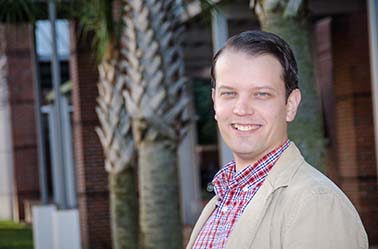Dr. Gregory Hudalla, assistant professor & J. Crayton Pruitt Family Term Professor, and UF researchers’ article titled, “Hierarchical Self-assembly and Emergent Function of Densely Glycosylated Peptide Nanofibers,” was published in Communications Chemistry.
A team of researchers at the University of Florida reports in Communications Chemistry that glycosylation can direct the self-assembly of peptide nanofibers into ordered networks with emergent functional properties.
Carbohydrates are the most abundant organic molecules on earth. In our daily lives, we encounter a vast array of natural entities assembled from carbohydrates. Cellulose, a polymer of glucose, is the primary structural component of the plant cell wall, while chitin is a key component of the exoskeletons of insects and crustaceans. Likewise, nearly half of all mammalian proteins are modified by carbohydrates (i.e., glycosylated), which can guide their organization into complex functional superstructures, as seen for flagella and mucus.
However, employing carbohydrates to assemble synthetic biomaterials has lagged far behind the use of other biomolecules, such as amino acids, lipids, and nucleotides, from which a diverse array of synthetic structures can be realized.
The team observed that glycosylation of synthetic peptides can create specific contact points that direct the lateral association of peptide nanofibers into aligned networks. The organization of glycosylated nanofibers into an aligned superstructure leads to biomaterials with new functional properties not seen for networks assembled from non-glycosylated peptides. For example, networks of nanofibers modified with the sugar N-acetylglucosamine are resistant to fouling by bacteria and mammalian cells, yet selectively capture carbohydrate-binding proteins, similar to mucus and other natural glycosylated superstructures.
Analogous to the influence of glycosylation on protein form and function, this report demonstrates that carbohydrates can also endow new properties to biomaterials assembled from peptides. Moving forward, the team envisions that modifying peptides with the diverse carbohydrate chemistries found throughout nature will lead to synthetic materials with a broad range of emergent properties that are useful for various medical and biotechnological applications.
Researchers:
- Thomas E. Angelini, Ph.D. Associate Professor, Department of Mechanical and Aerospace Engineering
- Shaheen A. Farhadi, Ph.D. candidate, Department of Biomedical Engineering
- Gregory Hudalla, Ph.D., Assistant Professor, Department of Biomedical Engineering
- Karen L. Kelley, Electron Microscopy Scientific Research Manager, Interdisciplinary Center for Biotechnology Research
- Kevin R. Knox, M.S., Department of Biomedical Engineering
- Justin J. Kurian, Ph.D., UF Department of Biochemistry and Molecular Biology
- Christopher S. O’Bryan, Ph.D., UF Department of Mechanical and Aerospace Engineering,
- Antonietta Restuccia, Ph.D., Department of Biomedical Engineering
- Dillon T. Seroski, Ph.D. student, Department of Biomedical Engineering
